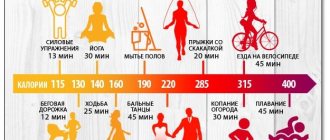The number of calories a person burns while walking depends on a number of factors, including height, weight and walking speed. Walking also offers many other health benefits, such as reducing the risk of heart disease.
Humans use energy from food and drink to maintain body functions and perform physical activities. Calories are a measure of how much energy the body gets from certain foods or drinks. When a person consumes more calories than they burn, the body stores this excess energy as fat. When the body needs more energy than it can get from the calories it consumes, it burns stored fat for energy. Regular physical activity maintains a healthy amount of body fat. While other forms of physical activity can be time-consuming or expensive, walking is convenient and free.
Walking for weight loss: how many calories are burned, how much you need to walk
When you want to lose weight, many diet programs and health experts recommend brisk walking as a cardio exercise that burns calories. But how much and how much walking should you do to help you achieve your weight loss goals?
How long should you walk every day to lose weight?
Aim for a brisk walk of 30 to 90 minutes most days of the week for weight loss. Some days you can walk more and others less, but the total time per week should be at least 150 minutes (2.5 hours).
You should be walking fast enough to be in the moderate-intensity exercise zone at 60 to 70 percent of your maximum heart rate. You should be breathing heavier than usual, be able to speak in full sentences, but not sing at all.
You can use the heart rate readings of a fitness app or heart rate monitor to make sure you're exercising at a moderate intensity.
While you can break up your walking time into 10 minutes or more, you'll get an extra fat-burning benefit if you walk at a faster pace for more than 30 minutes after you warm up.
If you're new to walking, start with shorter brisk walking periods and gradually increase your brisk walking time. You may want to take longer walks every other day.
Try not to miss more than one day in a row. Consistency is good for burning calories and improving your metabolism, as well as developing new habits. On non-walking days, try strength training. If you're feeling exhausted, take a day off. But don't forget to return to the track the next day.
If you've reached your weight loss goal and are working to maintain your weight, experts recommend walking 60 to 90 minutes most days of the week for moderate-intensity exercise without consuming more calories than you burn all day.
How far can you walk in 30 minutes?
If you walk at a fast pace for 30 minutes, the distance you travel will be:
From 2.5 to 3.3 km From 3000 to 4500 pedometer steps.
What if you can't take 30 minutes to walk at a time?
If your schedule doesn't allow for 30 minutes of walking continuously, break it up into two or three times a day for shorter periods of at least 10 minutes at a brisk pace.
Always warm up for five minutes at an easy pace, no matter what duration you're aiming for. You can use more intense intervals, stairs, and brisk walking to get the most out of short walking workouts.
Research published in 2021 shows that high-intensity intervals are at least as good as continuous, moderate-intensity workouts.
How many calories are burned in 30 minutes of walking?
When walking briskly, you will burn from 100 to 300 calories in 30 minutes (depending on your weight) or from 200 to 600 calories in an hour. When walking for 30 minutes or more, some of the calories burned will come from stored fat.
During the first 30 minutes of exercise, your body burns stored carbohydrates for fuel. They burn completely in about 30 minutes. To keep going, your body releases fat from fat cells and burns it as fuel. Stored fat is exactly what you want to lose, and it's a good reason to increase your walking endurance so you can walk for more than 30 minutes at a time.
Walk most days of the week for at least 30 minutes to burn an extra 1,000 to 3,000 calories per week and improve your metabolism every day.
What are the benefits of walking?
Many are accustomed to thinking that if you get cardio exercise, it must be through running, cycling or skiing. However, walking, just like the exercises listed, strengthens the cardiovascular system, being the most non-traumatic type of activity.
Here are just some of the most noticeable benefits that walking gives your body:
- helps you lose weight or maintain a healthy weight;
- long and fast walks increase endurance;
- helps prevent or manage chronic diseases;
- for people leading a sedentary lifestyle, 20 minutes of walking a day reduces the risk of premature death by 16-30% (American Journal of Clinical Nutrition study);
- for older people, an hour's walk 3 times a week reduces the risk of dementia;
- walking strengthens the heart;
- relieves stress, reduces anxiety;
- Walking as a means of cross-training allows your joints and muscles that are actively involved in running to rest;
- On a rest day from training, walking is an effective way to burn fat and increase blood flow for muscle recovery.
How many calories does walking burn? Intense walking. Calorie counter
Today it is necessary to be fit, cheerful and beautiful. Young people are going to the gym again, many are starting to run in the morning. This is a great trend and should definitely be supported. But today the topic of our article is slightly different. Not everyone can afford to go to the gym, and an untrained body cannot stand running, especially if there are a certain amount of extra pounds. An alternative can be simple walking. Today we want to take a closer look at how many calories walking burns. By answering this question, you can build a balanced diet to enhance the effect.
Walking or running?
Many will confidently say that the second is more effective. On the one hand, they are right, since running will accelerate metabolic processes much faster and also activate fat burning. Now imagine that a person has not five, but twenty-five extra pounds. Will it be easy for him to run? Of course not. That’s why we decided today to dispel the myths and tell you how many calories walking burns.
If we compare these two options for sports activity, then running is a more serious test for the body. That is, it is advisable to consult a doctor before going out onto the strip. Fast walking, on the contrary, will not harm, but will only improve the functioning of the heart and lungs and make the figure more graceful. This is the most environmentally friendly type of sports activity. We can walk tens of kilometers a day and not even notice it. Fatigue appears only with intense walking, or when it is performed without preparation.

How to calculate fuel consumption?
Like a machine, the body has certain costs for the biological processes taking place inside. The more intense the load, the higher the consumption. You can give approximate numbers of how many calories walking burns. One hour of walking can burn between 200 and 300 calories. But you should not take this indicator as an axiom. Your walking performance will be affected by your age and health status, initial weight, metabolism and duration of the walk. In addition, diet is very important. Nutrition will be a key factor if you want to lose weight. Chips and cakes give you more calories than you can burn even if you walk all day.

Correct technique
To walk properly and burn more calories, you need to:
- place your foot with the weight transferred from heel to toe;
- take comfortable short steps;
- keep your feet toned and not relax even when climbing uphill;
- Don’t sway your hips like a model;
- squeeze your buttocks and keep your abs toned when standing on your heel;
- slightly spring in the knees to cushion the spine;
- clench your hands and swing them in time with your steps;
- turn your body slightly during steps;
- keep your spine straight;
- straighten your chest, but do not lift your chin high to avoid additional stress on your neck.
Rules for walking for weight loss:
Exact numbers
Walking is an ideal way for those who have just set out on the path to health. At this moment, you should not overload yourself with physical activity, since there is a high risk of failure. But going for a walk is very useful, especially when the whole family sits down to dinner. How to calculate how many calories you will burn? We will give you the most accurate formulas, using which you will understand exactly what your walk will entail.
- Walking on a flat road. On average, the speed in this case can be 4 km/h. It's not too fast or tiring, but it's noticeable. So, in an hour you spend 3.2 Kcal for every kilogram of weight. If your weight is 100 kg, then the consumption will be 320 Kcal. Ice cream alone will more than compensate for your losses, so watch your diet.
- Let's see how fast walking affects the beauty of your figure. How many calories does a person burn if his speed is 4.5 km/h? The results are already more interesting - 4.5 Kcal per kilogram. If you increase the speed to 8 km/h, then this will already be 10 Kcal per kilogram.
- Walking calmly uphill also increases costs - at a speed of 2 km/h you will lose 6.6 Kcal/kg of weight.
- A walk in nature (through the forest, sea coast, sand) allows you to consume approximately 6.4 Kcal per kilogram.

The number of calories spent walking in 1 hour at different speeds
Beginning athletes are very concerned about how many kcal are spent when walking. This is a controversial question, since how many calories are lost in the body depends on many indicators: the patient’s age, weight, speed of movement, length and duration of movement. The easiest way to calculate energy costs is relative to a kilogram of your own weight for one hour of walking:
- Flat road, speed up to 4 km per hour - 3.2 kilocalories per kilogram of your weight.
- Flat road, speed up to 6 km per hour - 4.5 kilocalories.
- Flat road, speed up to 8 km per hour - 10 kilocalories.
- Climbing up a slope at a speed of up to 2 km per hour - 6.4 kilocalories.
- Long walks in the fresh air (at least two hours) - 6.4 kilocalories.
- Race walking - 6.8 kilocalories.
Those. For an hour-long walk at a speed of up to 6 km/hour, a woman weighing 60 kg will spend about 360 kcal. The list also shows that the greatest amount of energy is spent when walking fast, but such a load is suitable for experienced athletes, and can cause health problems for beginners.
Important! Do not start your introduction to walking with maximum loads. You will “undermine” your body’s defenses, become overtired and become disillusioned with this method of activity.
Choose a load according to your age and strength, this will be much more useful and beneficial.
How to calculate your own speed?
There is nothing complicated about this: knowing a simple formula, you can always calculate your speed. This will help turn the abstract concept of “fast walking” into something more real. It’s easy to estimate how many calories you’ll burn if you count the number of steps. If you walk at a speed of 3 km per hour, you take 50 steps in one minute. A speed of 4.5 km/h will allow you to take 75 steps per minute, and 6 km/h will allow you to take 100 steps per minute. That is, if you take 125 steps per minute, you can easily count on losing 10 kcal per kilogram of weight. This is an impressive figure, considering that not every workout in the gym will give you such results.
How fast and how long should you walk to lose weight?
Note that a leisurely walk in the park will not give you enough exercise to increase calorie burning. You need to walk quickly, although, of course, not as quickly as sports walkers rush.
Active burning of calories begins not from the fact that you make any movements, but from an increase in heart rate. For most people, brisk walking starts at 5 km/h (12 min/km). When walking 7 km/h (08:34 min/km) you will burn the same number of calories as when running at the same pace, but even a beginner can run at this pace, but not even an experienced runner can walk.
Trainers recommend varying your walking pace, just as we do during running workouts. Walk at a fast, uncomfortable pace for two minutes, then slow down to a comfortable pace. Repeat as many times as you like. In addition to actively burning calories, it will improve your aerobic fitness. Your heart rate should rise to at least 100 beats at an accelerated pace.
If you run in addition to walking, an hour of brisk walking is enough to increase your daily calorie expenditure. Thus, in Kenneth Cooper’s work “The New Aerobics: A System of Health-improving Physical Exercises for All Ages,” it is said that to achieve satisfactory fitness, you need to walk 6.5 km at an accelerated pace. In general, this is enough for an hour's walk.
So, let’s summarize the effect of walking on weight loss:
- Running burns more calories than walking, but maintaining a high intensity for a long time is more difficult.
- Due to the lower intensity of walking, a higher percentage of calories burned comes from fat burning, but there is no afterburn effect.
- Both walking and running burn enough calories to help you lose weight, but only if you make the necessary changes to your diet at the same time.
Why do you need to count?
Knowing what 1 hour of walking does, how many calories such a simple exercise burns, you will stop looking for excuses not to go to the gym. You don’t need to look for time and money for this - just go out into the yard and perform simple movements. Knowing the above formulas, you can easily calculate your walking time to create a negative energy balance. In principle, you can determine the speed by eye. If you are walking at a walking pace, then your speed is 3-4 km per hour. The average walking pace is already 5 km per hour.

Walk with poles
Nordic walking is considered one of the most effective methods of increasing the quantitative indicator of calorie burning. Every person, at any age and with any level of physical fitness, can use it, appreciating how effective this sport is and getting incredible results from it. During Nordic walking, up to 90 percent of the muscle mass throughout the body is used, and 46 percent more calories are lost than during regular training.
With the help of sticks, the level of stress on the following parts of the body is reduced:
- ankle joint;
- knees;
- as well as on the area of the hip joints.
This method of walking is considered the most effective, since the load on the legs increases instantly and significantly, plus the muscle fibers of the upper back and arms are connected to the overall work of the whole body.
Treadmill
The best alternative to street walking is a treadmill. The average speed of an ordinary person reaches 4-5 km. per hour, so to increase the level of calories burned, it is recommended to increase the pace of walking on the track to 6.5 km. at one o'clock. As the pace increases, energy consumption increases almost 3 times.
Walk on uneven terrain
If you walk on uneven surfaces such as grass, paths, snow, sand, or gravel, your caloric expenditure will at least double. You can also walk at an average pace along stairs or along mountain paths. And walking forward with your back will help improve your posture, tighten your butt and pump up your calf muscle fibers. Don’t forget about proper nutrition, since it is a balanced diet in combination with sports training that will contribute to the most effective burning of excess fat and preventing its re-gain.
How many calories are burned when walking? This question worries many men and women who want to lose weight. Running, of course, is more effective in this matter, but can lead to health problems. Fast walking is a safe way to make your figure slimmer, improve the functioning of your heart and lungs, and at the same time have a good time.
Usually a person walks from one to ten kilometers a day and doesn’t even notice it. Fatigue appears if you do it intensively and without preparation. Walking in the fresh air quickly lifts your spirits and gives you strength.
In one hour of brisk walking you can burn an average of 200 to 300 kcal. But you should not take this indicator as a standard, because the calculation takes into account a large number of factors: weight, age, metabolism, duration of the walk, etc.
If you walk on a flat paved road, you will burn fewer calories than walking through a forest with undulating terrain. Take man's best friend with you - a dog - and then the cost per hour will be even higher. A little general information, and it's time to move on to specific numbers.
So how many calories does walking burn?
We provide data based on 1 kg for one hour:
- flat road 4 km/h – 3.2 kcal;
- the same, speed 6 km/h – 4.5 kcal;
- the same, speed 8 km/h – 10 kcal;
- walking uphill 2 km/h – 6.4 kcal;
- walks in nature (forest, sea or river banks, parks with dirt sloping paths) - 6.4 kcal;
- race walking – 6.8 kcal.
Knowing this data, you can easily calculate your walking time in such a way as to create a negative energy balance. We'll make the speed calculation a little easier. On average, a walk of 3 km/h takes 50 steps/min, 4.5 km/h takes 75 steps, and 6 km/h takes 100 steps. Further, according to the proportion, it will not be difficult to reach the desired value. If you count “by eye”, then 5 km/hour is an average walking pace, and 3-4 km is a regular walk.
Basic Rules
They must be strictly observed. Even knowing how many calories a 1 km walk burns, we will greatly limit this result and negate the effect by interrupting walking after 30-40 minutes.
- The walk must last at least an hour. In the first 40 minutes, energy will be consumed from carbohydrate reserves that have not yet had time to turn into fat.
- Meals must also follow a certain schedule. It is best to go for a walk a few hours after you have eaten. But after a walk it is better to refrain from eating. As a last resort, allow yourself a small snack. A full meal should not be eaten earlier than 2 hours after training, and in this case, after a walk.
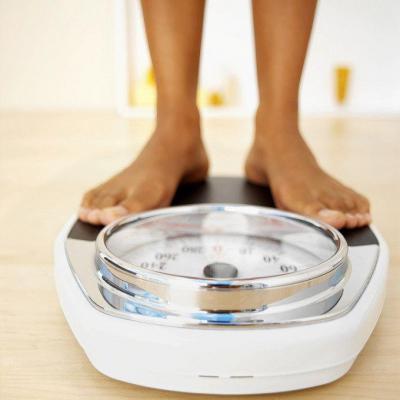
HOW TO WALK CORRECTLY
You don’t need to immediately start walking quickly for 3 hours a day. Especially if you are no longer 20 years old and do not weigh 50 kg. Start with hour-long walks at a slow pace. Then increase the pace for 5 minutes, then for 10 minutes and so on. Gradually you will begin to walk for 1 hour at an average pace. Want to spend more energy? Then increase the pace again and add time.
The main rule is to walk for at least an hour. When walking, fat begins to be burned no earlier than forty minutes later. Our body is extremely thrifty and first spends available carbohydrates.
Also remember not to exercise immediately after eating. The optimal time for training is an hour after eating. And when you finish your classes, don't rush to eat. Drink a glass of water. You can indulge in an apple or a banana smoothie.
While walking, remember to breathe. Inhale through the nose, exhale through the mouth. It is also important to quit smoking. It negatively affects breathing and the cardiovascular system. Shortness of breath and even dizziness will appear.
Give yourself a nice gift. Buy nice sportswear and comfortable sneakers. Better yet, buy special clothes that help burn fat. For example, breeches for weight loss. They create a sauna effect and help you lose weight much faster.

Some walking tricks
Thus, we have already found out that intensive walking provides the most benefits. How many calories this exercise burns is also clear, now you can calculate the load you need. However, this matter has its own secrets, which are very important to know for everyone who wants to effectively lose weight.
- The less you weigh, the less the loss will be, this applies to children, so they can run as much as they want, but they are not in danger of exhaustion.
- The taller a person is, the more calories he will burn. This is easy to explain: the fact is that a tall person takes more steps than a short person.
- The longer the walk, the better the result, so try to allocate at least an hour for it.
- To burn more calories, it is better to go up. Moreover, you don’t need to look for a mountain and a hill for yourself. All you have to do is go up to the 9th floor, then take the elevator down and do it all again. When moving up, you will lose 1,300 Kcal per hour. This is an excellent figure, but the gym will be less effective in this regard.

How and how much you need to walk per day
Ten thousand steps is a figure that has been recognized as a standard daily requirement, taking into account research and the positive effect on the health of the body. Doctors recommend taking at least eight thousand steps daily. Such movements are the best means of preventing diseases. Positively influence an active lifestyle.
Many people do not set a goal to walk a given number of steps; it depends on the person’s lifestyle and work activity. To feel energized and stay fit, try simply walking. With the help of walking, you can lose extra pounds, improve your health, and increase your mood and positivity.
On average, a person can walk half the norm per day. When working sedentarily, it is difficult to take the required number of steps. By increasing your speed and pace, achieve the same results as when moving normally. It’s easier for couriers in this regard; they can cover three times as much distance.
When working in an office, try to take a ten-minute walk outside during breaks. Improved well-being is guaranteed.
How much to walk to lose extra pounds?
If you want to remove the kilograms that are hindering your figure, make a goal - walk at least 15,000 steps. Fitness bracelets are used to count steps taken; when purchasing a device, you need to learn about entering user parameters in order to receive reliable data.
Some people use a special program in their phones; the device can increase the amount when it vibrates when moving.
By doing daily exercise walks of 10-15 thousand steps and maintaining a diet, it is easy to lose weight without exhausting yourself with heavy loads in the gym. A person weighing 70 kilograms burns approximately 440 calories while doing race walking.
How many steps do children need for healthy development?
A growing body is full of energy, ten thousand for children is the minimum figure. Fidgeting without counting steps heals the body. Overweight children who are less mobile should take 15,000 steps. This will improve your well-being and remove the required amount of calories.
How many steps do retirees need to take?
People of retirement age, like no one else, should take care of their health. Over the years, a person’s performance capacity decreases, which affects well-being.
To delay premature aging, you need to walk or jog a lot. Starting at age 50, the norm is at least 5,000 steps per day.
Let's start training
If you are inspired by the idea of starting walking, then first of all you need to remember that this is a serious physical activity for which you must prepare. That is, first of all, you need to warm up so as not to injure yourself. The first workouts should not exceed 25 minutes. You can gradually increase the load, but be sure to focus on your health. If you feel pain, severe shortness of breath, or dizziness, you need to stop exercising and consult a doctor.
Sleep well

This isn't technically a calorie burn, but it is critical in helping you reap the benefits of other activities. When we are tired, there is a great desire to skip workouts. Healthy sleep leads to better performance in everything, including training.
Has Terry convinced you? Now the path to health is open! Without sports and diet. But if you regularly visit fitness centers, don't quit. Just when you are at home, remember the good advice of this wonderful girl. Do you have similar tricks to burn calories while lying on the couch?
Calculating the diet
This is the second important question to consider before taking up sports. What do you want to use your calories for? Probably to lose weight, that is, reduce body fat. Therefore, a calorie counter will be a must. This is a regular notepad or a special program in which you enter everything you ate during the day. The average norm per day is 1800-2000 kcal. To lose weight, you need to create a calorie deficit.
This is exactly the function that walking performs. If you consume 1,800 Kcal, and burned 500 Kcal in an hour of walking, then you will steadily reduce your weight by reducing fat reserves. If your calorie intake is 2,500 kcal per day, then walking will allow you to maintain a stable weight, that is, not gain weight. And if you eat fatty and sweet foods, when your calorie intake is 3,000 kcal or more, you will steadily gain weight, despite walking. The calorie counter helps you estimate your diet. It is recommended that you simply enter your real data for a week. After that, build a schedule, evaluate the results and rearrange your diet in such a way as to leave more healthy and less high-calorie foods.
Heels, sleep and dancing: scientists on how to burn more calories without the gym
Don't like going to the gym? Indeed, why spend extra money on fitness centers. You can easily get in good physical shape without tedious and, importantly, expensive exercise on treadmills. It may sound strange, but you can burn up to 350 calories without noticing it just through your daily routine and habits.

Terri-Ann Nunns is the co-founder of Happy Healthy Mum Plan and creator of Terri Ann's 123 Diet Plan. From her own experience, she was convinced that there are many ways to lose weight without going to the gym. There are really simple rules that you can use in your daily life to lose weight. Even when you're sitting at your desk, doing certain exercises can increase the number of calories you burn. So here are some of the best alternative "exercises" the 32-year-old woman suggests for burning fat. In this case, you do not need to visit the gym.
Energy consumption when walking
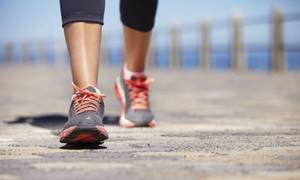
The most energy is consumed during heavy loads, active training, and professional sports. But this suits few people. But walking is accessible even to city residents. This is a gentle, gentle, but at the same time effective way to increase daily calorie consumption and lose weight.
Energy consumption when walking depends on many factors:
- Human weight. The relationship is direct: the larger the mass, the harder you will have to work to move it and the more energy you need for this.
- Movement speed. Fast walking promotes more active burning of fat deposits, so you should not overestimate your strength and start running.
- Additional loads. Climbing stairs or rough terrain, carrying a heavy backpack, swinging your arms and turning around - all this also increases energy costs.
- External factors, including weather. It is important to understand that in the heat more water comes out, which is why weight loss is noticeable. But it is in the cold that there is an increased consumption of fat, since calories are needed for steps and heating at the same time.
Basic values are calculated when moving on the plain with an average walking speed of 4-5 km/h. With a body weight of 60 kg, 60 minutes of such a walk will consume 220-260 kcal, and with a weight of 75 kg, the consumption will be 280-310 kcal.
Fitness bracelets and smartphones for calculating calorie consumption
![]()
The fitness bracelet has a built-in motion sensor – an accelerometer. The smartphone, on which a special application should be installed, receives sensor readings via the Bluetooth wireless network and converts them into steps. And then the steps are recalculated into kilometers and calories according to the user’s weight, height and age specified when launching the application. It is clear that in this case, the accuracy of estimating calories burned is very low.
An accelerometer can also be built into a smartphone, but here the error is even greater, since the smartphone should be worn in a place where the accelerometer can well sense the vibrations caused by walking, for example, in a trouser pocket. All such devices are designed for walking or running, and in fitness training mode their readings are even more unreliable.
Energy expenditure for different lifestyles

The type of work, as well as his gender and age, determine the energy requirements per day. The norms for men and older people are always lower.
- For those engaged in mental work, 1800-2000 kcal are required for women and 2100-2500 kcal for men per day.
- If the work can be characterized as light physical, then the energy requirement is 2100-2200 for the fair sex and 2500-2800 for the stronger sex.
- For average physical labor, you need 2500-2600 kcal for women and 3000-3300 for men daily.
There are quite detailed studies that show exactly how many calories are burned in a particular type of activity.
Energy consumption for different activities is shown in the table.

For example, during sleep and rest without movement, 1-1.5 kcal are spent every minute, and when washing floors and windows, 4-5 kcal are already spent. From here we can draw a simple conclusion: the more a person moves, the more energy he spends. If the body receives less “fuel” per day than it needs, it takes it from reserves - it uses up fat deposits. Therefore, when running or dancing at home, doing push-ups and other exercises, a calorie deficit appears if you do not increase your food intake. This way you can lose weight.
Race walking
It is this that, at a speed of 100 steps per minute, will allow you to break down fat in the subcutaneous tissue. You need to start with 10 minutes and gradually increase your daily walk at a sports pace to 40-45 minutes. Along with calories, you can get rid of extra centimeters on your waist and hips and in return get health, lightness and moral satisfaction.
To quickly tighten your buttocks, make your legs slender and remove belly fat, it is recommended to take dumbbells up to 1 kg with you for a walk or wear weights on your arms. During the first half of the distance, the left arm with a weight and the right leg are actively thrown out, then the right arm and left leg.
When walking quickly over a distance of 1 km, a short person (1.5 m tall) weighing 45 kg burns approximately 0.88 kcal per 1 kg of body weight, and with a height of 1.8 m and a weight of 86 kg - 0.74 kcal. Then, for example, walking 5 km, the first will spend 4.4 kcal/kg (198 kcal in total), and the second will spend 3.7 kcal/kg (318.2 kcal in total).
When walking at a brisk pace, you can burn more calories than at a leisurely pace, as can be seen in the table.
How many calories are spent walking?
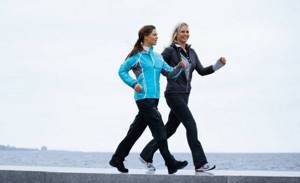
Those looking to lose weight by walking want to know how many calories are burned while walking. All calculations were made based on an active step at a speed of 5 km/h and a slow movement of 2 km/h. When choosing the duration of training, we must not forget that during short-term exercise, the body burns light sources - carbohydrates. He only burns fat during exercise that lasts more than 30 minutes.
When walking in 1 minute (+ 30,40,45 minutes)
Energy consumption for a walk depends on its duration. When walking normally at a good pace, 4-5 kcal are consumed in 1 minute. If you walk leisurely enough, then only 2-2.5 kcal.
- In half an hour of moving with a “confident step,” the body spends 120-150 kcal.
- If the promenade takes 40 minutes, then you can count on a loss of 160-200 kcal.
- A 45-minute walk will consume 180-225 kcal.
The duration of training depends on your work schedule and lifestyle. You can practice two small 30-minute walks a day, for example, walking to the office or taking a long evening promenade. Just remember that any physical exercise is contraindicated immediately after eating.
When walking for 1 hour

At a speed of 5 km/h, the body will consume 200-250 kcal in 60 minutes. Slow movements burn 120-150 kcal per hour walk.
When walking 1 km
To calculate how many calories are burned per kilometer of walking, you need to remember that rhythmic movements allow you to cover this distance in 12 minutes. Accordingly, energy consumption will be approximately 50-60 kcal. If you walk slowly, it will take 30 minutes in time and 75 kcal in calories.
10000 steps
To calculate the energy consumption for such a distance, it first needs to be converted to km. 10 thousand is 6 or 7 km depending on the width of the step. Approximate losses will be 300-350 kcal. To count steps, the easiest way is to buy yourself a fitness bracelet.
This distance can be covered in an hour of active movement. Accordingly, the values are the same (up to 250 kcal). This route is also equivalent to a quiet two-hour walk with a stroller, which will take 250-300 kcal.
How long is it recommended to walk each day?
Everyone has probably heard about 10 thousand steps a day to get rid of all diseases and problems? As in the case of 2 liters of water, this is a stereotype. And it comes from Japan, where the inventor of the first electronic pedometer, Yoshiro Hatano, called it Mampo-kei. Translated into Russian, this means “10,000 steps.” One version of why Yoshiro named his invention this way is that it’s just a beautiful round number.
10,000 steps is approximately 8 km. And many, of course, are frightened by this figure. There is no need to take it literally, because there are a lot of variables: what surface a person moves on, at what speed, in what weather conditions and, finally, what kind of training a person has. Even going up from the 1st floor to the 18th-20th floor a couple of times carries a load that is much greater than idle wandering throughout the day.
A simple rule: less is better, but more is more active. Research from the Active 10 Project shows that 3 brisk, 10-minute walks a day are healthier than 10,000 slow steps. In addition, short but fast walks are better suited for the modern rhythm of life.
The recommended rate of physical activity for a person is at least 150 minutes per week. Such recommendations are given by the World Health Organization. Walking or other activity should be done at least 30 minutes a day, 5 times a week. And this is just to maintain health. Note that physical activity can be distributed throughout the day:
- 10 minutes of brisk walking three times a day;
- or 20 minutes in the morning and 10 minutes later during the day.
Doctors advise counting not the steps taken, but the total time of physical activity, but if you are still interested in the numbers of steps taken, there are now many fitness bracelets on the market with a step counting function. The same mobile applications can be installed on any smartphone.
How many calories are burned when walking up stairs?

Climbing stairs requires much more effort than climbing a flat road. The effectiveness of such exercises depends on the height of the step, intensity and time of movement. On average, up to 550-700 kcal are lost per hour, but it’s difficult to hold out for that long.
It is best to refuse the elevator and walk up to the apartment. You should start small, adding only 1 floor per week, so that there is no severe shortness of breath and palpitations, and harm to health. You can walk up the stairs to the 5th floor at a good pace in 5 minutes. One such “race” is minus 50-60 kcal. For more information about walking on stairs for weight loss, read the link.
Types of walking for weight loss
To quickly achieve weight loss, it is recommended to engage in race walking. It will help you quickly get rid of extra pounds. The essence of it is to take small steps, placing your feet in a straight line. Your arms should be bent at the elbows. Such walking not only helps you lose weight, but also makes your legs slender, your stomach flat, and your buttocks toned. If you pick up dumbbells that weigh less than a kilogram, you will achieve the result much faster. In this case, you can perform the following exercises. When extending your right leg, your left arm should be placed in front of you, without bending it at the elbow. The same must be done in the other direction. This exercise is only performed halfway, and the second half should be performed with a simple athletic step.
In addition to race walking, other types of movement are also effective in losing weight.
- Walking in reverse. In this case we are talking about walking backwards. It will help tighten your buttocks and flatten your stomach. The movement should start slowly, gradually increasing the pace. It's best to have someone nearby to help you avoid tripping.
- Climbing up. If you do not move on a flat surface, but start going uphill or up steps, you will achieve results much faster.
- Walking with tense buttocks and a straight back will increase efficiency and calories will be burned much faster.
- Nordic walking with poles. This type of exercise is suitable even for older people. This walking increases calorie burning by 45%. It guarantees weight loss of an average of 3 kg per week.
How many calories are burned during Nordic walking?
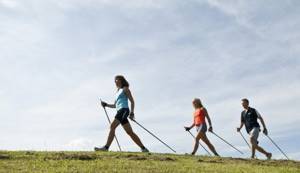
Nordic walking differs from regular walking in that it uses special poles. Relying on them reduces the load on the joints, but at the same time 95% of the muscles are included in the work. This is more than when running.
- more intense fat burning;
- walks are always in the fresh air, often in company;
- pumping up the abs and buttocks if you follow the steps correctly;
- less risk of injury;
- a good alternative to running if it is contraindicated;
- improves posture, coordination, sense of balance.
It's always a fast pace, otherwise you won't be able to keep the rhythm. For every minute the body loses 5.2 kcal, per hour 350 kcal. Training should be at least 30-40 minutes. Nordic walking can combine movement through the forest, slopes, and snow in winter, which only enhances its effectiveness up to 700 kcal per hour.
Benefits of walking
It turns out that walking is a wonderful sport. Yes, yes, walking is a sport. The benefits from it are special. After all, it trains all the same muscles as running. At the same time, it does not have a negative effect on the knee joints. Plus it improves heart function and saturates our cells with oxygen. Everyone can walk: fat and thin, old and young.
Many people care about the topic of weight loss. It is very difficult to fight the hated kilograms while sitting. Forcing yourself to play sports is even more difficult. But going for a walk in the evening after work is as easy as shelling pears!
Increase in consumption

There are many techniques to increase the intensity of exercise: weighting, swinging your arms, walking in heels, moving with sticks and even on crutches. Their main goal is to use as many muscles as possible and increase the load. You can combine walking with tension in your buttocks and abs, and do inserts of steps with your knees raised high. It is also good to walk short distances backwards, go down and up slopes. This will not only enhance the effect of losing weight and help you lose excess weight faster, but will also make your classes more varied and not boring.
Many people are interested in the question, how many calories are burned when walking in place? In fact, this is a very intense exercise due to the pace and knees that rise high. It destroys 58 kcal in 5 minutes.
Hand movements
This is the simplest and most accessible way to everyone. It will help you work out your upper body and stretch your shoulders when sitting at the computer for a long time. It is enough to bend your elbows at an angle of 90 degrees and move them back and forth in rhythm with steps.
Additional weighting
Some trainers recommend putting extra weight on your arms or legs, while others recommend wearing a backpack filled with bottles of water or sand.
This way there is less chance of damaging your legs. The weight of the “additional weight” is of great importance: the larger it is, the faster fat will be burned. If you carry a load of 10 kg with you, this will increase the effectiveness of training by 13%, with 20 kg it will increase by 31%. If the number of weights is significant and their mass is 30 kg, this will increase the result by 60%.
Hiking with ski poles
Even regular ski poles provide intense movement. They are good for both children and older people. This simple equipment increases the effectiveness of classes by 40%. In winter, it is good to practice skiing; it is 2.5-3 times better at losing excess weight.
Running trainer
A treadmill is a good alternative to outings when you need to exercise and it’s raining or snowing outside. Moreover, the simulator allows you to adjust the speed from 4 to 6.5 km/h. If desired, exercises on the stepper can be supplemented with arm swings. There are simpler mechanical exercise machines, as well as elliptical ones, which are suitable for walking, running, and cycling.
Uneven terrain

A flat, smooth road means minimal load. Moving through grass or forest increases costs by 10-15%. If the terrain has a slope, then climbing it uphill increases energy consumption by one and a half times. Trying to get through the snowdrifts is 2 times more effective.
On crutches
If your leg is in a cast, this is not a reason to stop training and move little, otherwise you can gain even more extra pounds. In terms of energy consumption, walking on crutches is equivalent to Scandinavian walking (350 kcal per hour of exercise). But you need to adapt to such equipment, because the load on your hands will be significant.
To lose weight, you don’t have to exhaust yourself with exercise equipment in the gym. Simple walking, if practiced regularly and for long distances, will help bring your weight back to normal. Fresh air and pleasant company in the form of friends or your beloved dog will make classes enjoyable.
Sources:
https://zen.yandex.ru/media/id/5a16dc428139ba9e8957c404/5d4bbdcace44a000ae44541c https://fb.ru/article/257451/skolko-kaloriy-sjigaet-hodba-intensivnaya-hodba-schetchik-kaloriy https://good- looks.info/skolko-kalorij-szhigaetsja-pri-hodbe.html
Calculate calorie consumption based on heart rate
In a state of rest while lying down, a person’s pulse is minimal and is called the resting pulse. When performing physical work, to meet the body's increased need for oxygen, the heart begins to beat faster, and the increase in heart rate is, to a first approximation, proportional to the power of the work performed (at the same time, at low loads, the heart rate is restrained by an increase in the volume of blood ejected by the heart into the aorta per contraction, and only then, when the stroke volume reaches its limit, does the load increase only due to increased heart rate).
You can calculate energy consumption when walking using the formula:
E = 0.002 x M x T x (P - PP)
where E is energy expenditure in kcal, M is body weight in kg, T is walking time in minutes, PP is resting pulse, and P is pulse during movement in beats per minute. The interesting thing about this formula is that it does not include the distance traveled, the speed, or the steepness of the climb - all this is taken into account by the heart rate.
The pulse rate can be measured by manual counting or with an electronic heart rate monitor, several times along the way, and take the average.
Example: A person weighing 70 kg walked a certain distance in 15 minutes, with a pulse of 90 beats/min, a resting pulse of 65 beats/min. Energy consumption is equal to 0.002 x 70 x 15 x (90 – 65) = 52 (kcal).
Such a calculation is also approximate, since the loss of calories when walking depends on the degree of training of a person (in trained people, compared to less trained people, performing the same work requires a lower heart rate), and the heart rate monitor is not able to evaluate it, and some information is lost.
There are also online calculators that allow you to calculate how many calories are burned when walking in an hour or other time. These walking calorie calculators usually require you to enter your weight, walking time, and distance traveled, and can be based on different algorithms since there is no single method for calculating how many calories you burn while walking for the reasons described above.
heels
Shoes are an important element of any woman's clothing. Heels are an integral part of any real lady. But how do shoes affect our weight loss and health? To begin with, it’s worth saying that what kind of shoes we wear, how comfortable they are and what heels they have, determines which muscles we tense.
You've probably noticed that when you put on heels after a long period of walking in flat shoes, you feel how tight your calves are. On the first evening, after wearing heels, your feet usually hurt or ache. This is fine. You used muscles that haven't worked for a long time. It's a lot like going to the gym for the first time. Something that you haven’t paid attention to for a long time will definitely hurt.
With the help of high-heeled shoes, you can pump up your calves beyond recognition. Note, however, that some doctors are categorically against heels. They say that high-heeled shoes contribute to spinal curvature, damage to joints and tendons, and pinching of spinal nerves.
shoes also affect our physical fitness
But it's not just your calves that get tense. If you were once taught how to walk beautifully in heels, or you attended modeling and catwalk courses, then you should know that the main point of a beautiful gait is the tense buttocks. No doubt it's hard. But just try it and you will notice how light and graceful you will become.
Imagine that you are holding a pea, which under no circumstances should fall. While heels tighten your glutes and calves, flat shoes work your thighs and abdomen. You feel comfortable in it and don’t even notice how you are losing weight. In addition, you can walk quickly in it.






